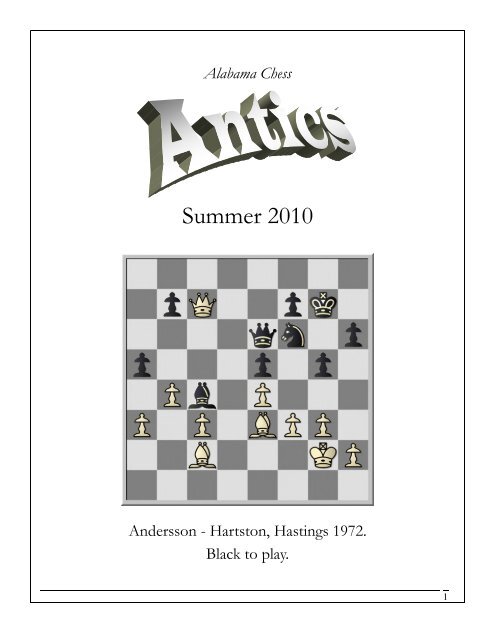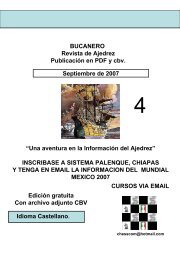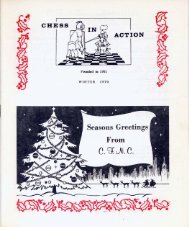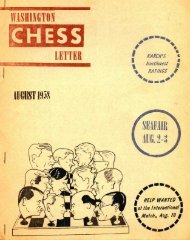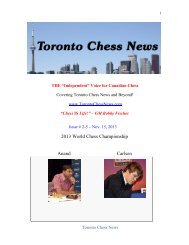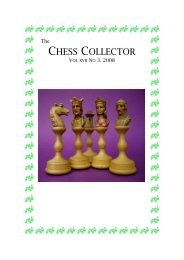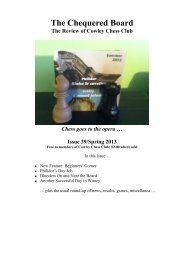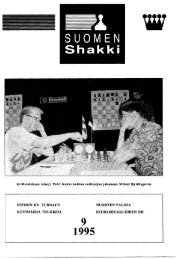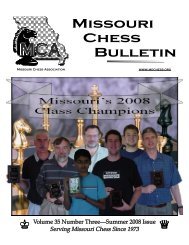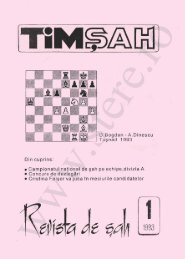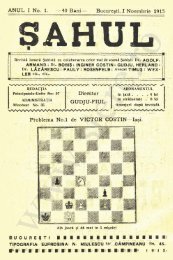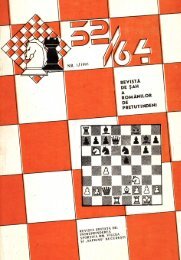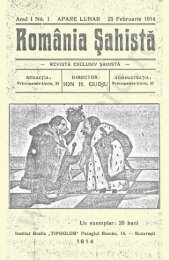Alabama Chess Antics
El ajedrez es un juego, considerado un deporte, entre dos personas, cada una de las cuales dispone de 16 piezas móviles que se colocan sobre un tablero dividido en 64 escaques. En su versión de competición está considerado como un deporte.
El ajedrez es un juego, considerado un deporte, entre dos personas, cada una de las cuales dispone de 16 piezas móviles que se colocan sobre un tablero dividido en 64 escaques. En su versión de competición está considerado como un deporte.
Create successful ePaper yourself
Turn your PDF publications into a flip-book with our unique Google optimized e-Paper software.
<strong>Alabama</strong> <strong>Chess</strong><br />
Summer 2010<br />
Andersson - Hartston, Hastings 1972.<br />
Black to play.<br />
1
Letter from the Editor<br />
This issue features outstanding games from two major summer tournaments in <strong>Alabama</strong>, namely, the<br />
Birmingham Classic and the Chris Bond Memorial. Both of these events saw a lot of gritty, hard-fought chess, but<br />
also some very elegant wins.<br />
First, we’ll look at my game against Bryan Tillis at the Birmingham Classic. I’m glad to report that, by<br />
winning this last-round game, I finished the tournament in first place with a 4-0 score. (Of course, I did get very<br />
lucky in some of the other rounds. Sorry, Will...) I really like games in which a small positional advantage slowly<br />
grows into total strategic domination; in that respect, this game with Bryan might even be my best game ever.<br />
Next, we have Will Stevenson’s wonderful combinative victory in round 2 of the Chris Bond Memorial.<br />
This game might be Will’s best game ever, as Will himself will attest; in my mind, it was certainly the best game of<br />
the tournament. The sparkling sacrificial attack at the game’s end makes a very strong impression.<br />
Then we turn to another battle from the CBM. Tom Lawry, who tied for first in the Open section (with Will<br />
and myself), has annotated his pivotal round 4 game against Will. This game was such a tense fight that, towards<br />
the end, I literally had to leave the room: I couldn’t stand to watch!<br />
Finally, we have a game from Chris Boothe, the winner on tiebreaks in the CBM’s Reserve section. (He<br />
and Carlos Matos finished in joint lead with four out of five points.) Congratulations, Chris!<br />
What can I say? I’m quite pleased with this issue of the <strong>Antics</strong>. Thanks so much, everybody, for submitting<br />
your games.<br />
Now, we look to the very near future: <strong>Alabama</strong>’s most prestigious event, the State Championship, is almost<br />
here. (See the TLA section for a detailed flyer.) It looks like the Freedom <strong>Chess</strong> Academy in Tuscaloosa is going to<br />
do a great job of hosting the tournament. Not to mention, the impressive prize fund should put the players in all the<br />
more of a fighting mood. I look forward to receiving some really nice games for the next <strong>Antics</strong>...<br />
Remember: if you want to find the <strong>Antics</strong> online, in larger print and in living color, you can go to<br />
www.alabamachess.com and download a copy in .pdf form for free. Also, please submit your games and articles to<br />
the <strong>Antics</strong> by e-mailing the editor at AL.antics.editor@gmail.com. A .pgn file is ideal, but a simple text or Word file<br />
would work too.<br />
Kindest regards,<br />
Scott Varagona<br />
________________________________________________________________________<br />
Solution to the puzzle on the cover: 36...Qh3+!! 0-1. If 37.Kxh3 then 37...Bf1 mate; on the other hand,<br />
37.Kh1 Qf1+ 38.Bg1 Qxf3 is mate as well. Yikes!<br />
Contents:<br />
Birmingham Classic 2010: My Finest Game in Years by Scott Varagona page 3<br />
A Beautiful Game from the 2010 CBM by Will Stevenson page 5<br />
Stevenson-Lawry: the Upset by Tom Lawry page 7<br />
CMB Reserve: Chris Boothe Wins! by Scott Varagona page 8<br />
Tournament Life Announcements page 10<br />
2
Birmingham Classic 2010: My Finest<br />
Game in Years<br />
by Scott Varagona<br />
Bryan Tillis (2116) − Scott Varagona (2160)<br />
Birmingham Classic 2010, Round 4<br />
Before we begin, here's a tip of the hat to<br />
Dothan's best, Bryan Tillis. Bryan and I have been<br />
friends ever since he was in high school; in all that<br />
time, I've enjoyed watching him grow from a Class B<br />
player to a strong Expert. Although we did some<br />
online training sessions off-and-on years ago, we<br />
never played a rated tournament game until 2008.<br />
We've been friendly rivals ever since.<br />
Still, my rivalry with Bryan is strangely hard to<br />
describe. Our games have been very... odd. Almost<br />
every time we've played, I've walked away with the<br />
feeling: "Wow, that was weird. I can't believe that just<br />
happened." For example, in our very first game (a<br />
Chigorin Defense), the tension was just beginning to<br />
build when a sudden tactic won me a crucial kingside<br />
pawn, and the game came grinding to a halt. The<br />
same sort of thing happened in our 2008 State<br />
Championship game, but that time, disaster struck<br />
during a drawn endgame. Our 2009 games weren't<br />
this anticlimactic, but nor were they as pleasant for<br />
me: with the Black pieces, I made a complete mess of<br />
things in the early middlegame, only to somehow<br />
wriggle out of trouble in both games (and even win<br />
one of them). So here we were again, and Bryan<br />
again had the White pieces. I knew he'd be out for<br />
revenge--hey, who wouldn't be?--but I still didn't<br />
expect him to open with 1. e4.<br />
1.e4 d5<br />
A surprise of my own. This is the first time (in a<br />
standard rated game) that I haven't answered 1.e4<br />
with 1...c6 since the year 2000! Well, I do love the<br />
Caro, but I've found that I like the Scandinavian too.<br />
And here, it seemed wise to avoid Bryan's Caro-Kann<br />
preparation, whatever it might have been...<br />
Never before had I seen this kind of restrained play<br />
from White in the Scandinavian Defense. Most<br />
players try to shoo Black's queen away from d5 as<br />
soon as possible, but Bryan has simply ignored her.<br />
No matter; I was just happy to achieve a harmonious<br />
development for my pieces.<br />
9.Re1 Qa5<br />
Well, I guess I didn't want to leave her there forever.<br />
10.Nbd2 Bxf3<br />
Creating an imbalance. I decided it was worth giving<br />
up the bishop for knight in order to lessen White's<br />
control of the e5 square. Besides, White's two bishops<br />
don't seem all that threatening, and my plan will<br />
involve limiting their influence even more.<br />
11.Bxf3 Qc7 12.g3 0–0 13.Nc4 Bb4! 14.c3 Be7<br />
15.Qe2 a5<br />
I was proud to have provoked c2-c3, which further<br />
blocks White's b2-bishop. Now I'm just gaining<br />
queenside space and hoping to provoke further<br />
weaknesses.<br />
16.Ne5 a4 17.c4 Bb4 18.Red1!?<br />
2.exd5 Qxd5 3.Nf3 c6 4.Be2 Nf6 5.d4 Bg4 6.0–0<br />
Nbd7 7.b3 e6 8.Bb2 Bd6<br />
A critical moment. Bryan sees what's coming and<br />
voluntarily sacrifices a pawn. He'll get to keep his two<br />
bishops and probably win the pawn back sooner or<br />
later. The bad news is, Black turns out to be very<br />
strong on the dark squares in the resulting position. I<br />
3
expected 18.Rec1, so that 18...a3 could be met with<br />
19.Bc3.<br />
18...a3! 19.Bc1<br />
could not realistically expect to win such an ending,<br />
and Bryan needed to win at all costs.<br />
28...h6 29.Bc1 e4 30.Be2 Qe6!<br />
The alternative, 19.Nxd7 Qxd7! 20.Bc1 Bc3 21.Rb1<br />
Bxd4 followed soon by ...e5 or ...c5, looks comfortable<br />
for Black.<br />
19...Nxe5 20.dxe5 Bc3 21.Rb1<br />
We both also had to calculate (and reject) the<br />
exchange sacrifice 21.exf6 Bxa1 22.Bf4 e5! 23.fxg7<br />
Kxg7. In that case, despite my open king, I'd be doing<br />
fine.<br />
21...Qxe5 22.Qc2 Rfd8<br />
Fritz the materialist calls for 22...Bb4, clinging to the<br />
pawn. Maybe that really was better, but it seems<br />
reasonable to let the pawn go and contest the d-file<br />
instead. Besides, a draw would have secured the<br />
tournament win: trading down to an even ending is<br />
fine by me.<br />
Quiet, “creeping” moves like this make me happy. The<br />
queen inches forward, controlling more squares and<br />
threatening ...Qe6-f5xf2+.<br />
31.h3 Qf5 32.Rf1?<br />
A mistake in time pressure: this is way too passive.<br />
31.Be3 was definitely called for here. Now my knight<br />
suddenly springs to life:<br />
32...Nd7! 33.Be3<br />
Maybe even 33. Bg4!?, to eliminate the knight, was<br />
worth a try, although White's light squares d3 and f3<br />
would get even weaker.<br />
33...Ne5 34.Bxd4 Rxd4 35.Rd1 Rad8 36.Rxd4 Rxd4<br />
37.Rxa3<br />
23.Bf4?!<br />
This came as quite a shock. I felt certain Bryan would<br />
take this chance to play 23.Bxa3!. Now it's going to<br />
take a lot longer to regain the pawn, and in the<br />
meantime Black will gradually improve his position.<br />
23...Qa5 24.Kg2 e5!<br />
I have a central majority: let's use it!<br />
25.Be3 Bd4 26.b4 Qc7 27.Bg5 Qe7 28.Rb3<br />
A serious alternative was 28.Qf5, pursuing an<br />
opposite color bishops ending after the possible<br />
28...h6?! 29.Bxf6 Qxf6 30.Qxf6 gxf6. However, the<br />
computer's 28...e4! improves on the above line by<br />
keeping Black's kingside from getting fractured. Then,<br />
even in the event of an opposite color bishops ending,<br />
Black would still have the upper hand because the<br />
rooks would remain on the board. At any rate, White<br />
4<br />
Regaining the pawn at last! But now it's too late.<br />
Black's pieces lord over the position.<br />
37...Nd3! 38.Bxd3 Qf3+! 39.Kg1<br />
Fritz shows that 39.Kh2 would have been a much<br />
more challenging defense, but it too would be<br />
insufficient in the end: 39.Kh2 exd3 40.Qd2 f5! 41.Rb3<br />
Qe2 42.Rb2 Qf1 43.Qe3 Re4 44.Qf3 Qe2! 45.Qxf5<br />
Qxb2 46.Qc8+ (46.Qxe4 Qxf2+ 47.Kh1 Qf1+ 48.Kh2
Qe2+) 46...Kf7 47.Qf5+ Qf6 48.Qxe4 Qxf2+ 49.Kh1<br />
d2.<br />
39...Rxd3 40.Rxd3 exd3 41.Qd2 Qe2!<br />
A Beautiful Game from the 2010<br />
Chris Bond Memorial<br />
by Will Stevenson<br />
Will Stevenson − Benjamin Levine<br />
(2167) (1629)<br />
Chris Bond Memorial 2010, Round 2<br />
White lost on time (0-1). This final position is<br />
remarkable to me because after 42.Qxe2 dxe2,<br />
White's king is so close to the passed pawn, but he<br />
just can't stop it! He's so close, yet so far away. On<br />
the other hand, after 42.Qf4 d2 43.Qb8+ Kh7, there is<br />
no perpetual check; Black will queen his pawn and<br />
win.<br />
I am very, very proud of this game. There was<br />
nothing really flashy about my play; I just slowly<br />
improved my position with little moves here and there<br />
until, suddenly, my advantage was overwhelming.<br />
Have you ever had one of those games where all your<br />
ideas seemed to "click," your pieces worked in perfect<br />
harmony, and you simply won? And then you said to<br />
yourself: "Wow, this is the way it's supposed to work!<br />
This--now this is chess." That was how this game<br />
made me feel. I think it's because of moments like<br />
these that I love chess so much, and I'll always keep<br />
coming back to play again.<br />
Special thanks to my best friend, Jonathan<br />
Clark, who takes a casual interest in chess. He<br />
recently drew my attention to the Scandinavian as a<br />
possible back-up defense; without him, this game<br />
never would have happened. Thanks also to Bryan<br />
Tillis for another interesting battle, and of course,<br />
thanks to all the players--and organizer Caesar<br />
Lawrence--for helping make this tournament such a<br />
big success.<br />
You never know what to expect when playing a kid. I<br />
always face a dilemma on what to open with against a<br />
kid. Conventional wisdom says to not play too<br />
theoretically and keep the position fairly closed. I,<br />
apparently, am NOT a wise man. That being said, my<br />
strategy produced one of the best (if not THE best)<br />
games I have played. So I can't complain.<br />
1.e4 c5 2.Nf3 d6 3.d4 cxd4 4.Nxd4 Nf6 5.Nc3 a6<br />
The most common defense in chess in the modern<br />
era, the Najdorf Defense (in this case, the<br />
Scheveningen through the Najdorf move order... i.e.<br />
a6 before e6).<br />
6.Be3<br />
The dangerous English Attack. The most popular<br />
response at all levels these days.<br />
6...Nc6<br />
Generally I am not too fond of this move. It kind of<br />
looks like a Najdorf/Classical Sicilian hybrid, seems to<br />
block Black's potential c-file pressure, and is less<br />
flexible than placing it on d7. However, none other<br />
than Kramnik and Gelfand have played it, so it can't<br />
be too bad!<br />
7.f3 e6 8.Qd2 Bd7 9.g4 h6<br />
5
The first interesting development. Playing ...h6 means<br />
that Black has no intentions of castling, which would<br />
give White an easy-to-exploit pawn lever.<br />
10.0-0-0 Be7 11.h4 Qc7<br />
...b5 is a little more normal, but this is just fine.<br />
Regardless, Black must get on with a queenside<br />
attack, as White's play is quite natural on the kingside.<br />
12.Kb1<br />
White had a choice between several natural<br />
development moves. Bh3 and Rg1 were also under<br />
consideration.<br />
12...b5 13.Nxc6<br />
A common motif in the Najdorf, to re-route the other<br />
knight to a strong central square and trade off Black's<br />
potential q-side attacker.<br />
13...Bxc6 14.Ne2?<br />
Probably the only wrong decision of the game.<br />
Laziness.<br />
This forced me to do a double-take. Certainly not the<br />
kind of move you see everyday. Best was probably<br />
searching for some counterplay with 18...d5 19.exd5<br />
Rd8 although it's difficult to see how Black is going to<br />
safely get the other rook into play.<br />
19.Qf2!<br />
A multi-purpose move. This prevents Rd8 in view of<br />
Bb6, it allows me to double rooks on the d-file and to<br />
prepare the maneuver Bb6-a5-b4 putting pressure on<br />
the d6 pawn potentially. I now have a free hand over<br />
more or less the entire board.<br />
19...Rhg8 20.Bg2 Ke8 21.Rd2 Nd7 22.Rhd1 Qd8<br />
It's really difficult to find a plan for Black at all. He's<br />
more or less relegated to passivity.<br />
23.Qg1 Rb8 24.f4 f6?<br />
This seriously weakening move makes things easier.<br />
This critically weakens the h5-e8 diagonal and the<br />
light-squares around the king.<br />
25.Bf3 Kf8 26.Rg2 exf4 27.Bxf4 Qe8 28.Rxd6<br />
14...Rc8?<br />
Missing his chance to equalize. 14...d5 and here I<br />
VERY lazily looked at the normal 15.e5 and assumed<br />
all was well. However, had I spent more than 10<br />
seconds on move 14 (usually not a problem... people<br />
certainly can't excuse a time-pressure addict like me<br />
of being too bad about this), I would have quickly<br />
seen that 15...Nd7 16.f4?? d4-+ is lost. I'm sure I<br />
wouldn't have played this, but this is the only stain on<br />
an otherwise excellent game. At least this woke me<br />
up and forced me to start concentrating.<br />
The start of a really nice sequence of moves. Not<br />
really worthy of a "!", however, as this is quite easy to<br />
spot quickly. Well, also the fact that people who<br />
constantly award themselves exclams can be rather<br />
annoying. However, from this point forward, I am just<br />
going to be annoying. :)<br />
28...Rd8 29.Rxg7!<br />
15.Nd4 Bd7 16.Bh3 e5?!<br />
This is a radical attempt to solve some problems.<br />
17.Nf5 Bxf5 18.gxf5 Kd7?<br />
6
33.Qg6!!<br />
Offering a rook for the 3rd time. Amazingly, Black is<br />
almost in zugzwang.<br />
33...Nxe6 34.fxe6<br />
An amazing position! Black is up a full rook AND an<br />
exchange but can only slide the rook along the back<br />
rank and push the q-side pawns while the e-pawn<br />
comes in to mate. It's now forced mate.<br />
34...a5 35.e5<br />
Seeing through to the end of the combo. However, I<br />
must say that I had a simpler backup option on move<br />
33, if the killer shot didn't work.<br />
And Benjamin resigned. What a picturesque final<br />
position! The pieces coordinated perfectly. Truly a<br />
game I won't soon forget! 1-0<br />
29...Rxg7 30.Bxh6 Qf7 31.Bh5!<br />
Rybka doesn't like this so much, but this just wins.<br />
However, maybe even better was a move that I<br />
looked at only briefly.... 31.Rxd7! Rxd7 32.Bh5!<br />
winning.<br />
31...Qg8<br />
Natural, but Black had to play 31...Qxh5! 32.Qxg7+<br />
Ke8 33.Rxa6 Nf8 (33...Qd1+ 34.Bc1 Rc8 35.Qg2±<br />
With a close to winning position for White despite<br />
Rybka's evaluation of only slightly better for White.<br />
With 2 humans playing, White should win.) 34.Ra7<br />
Rd7 35.Rxd7 Kxd7 36.e5 Qxf5 37.exf6 Qf1+ 38.Bc1<br />
Qxf6 39.Qxf6 Bxf6 40.h5 and White is playing for 2<br />
results. Excellent chances to win.<br />
32.Re6 Nc5<br />
Nothing can save Black now. 32...Qh7 33.Bxg7+<br />
Qxg7 34.Qxg7+ Kxg7 35.Rxe7+ is hopeless. And now<br />
I had seen the possibility to play this move on move<br />
29. However I knew I could always bail out and go<br />
into an easily winning endgame with Bxg7+ Qxg7<br />
Qxg7+ Kxg7 Rxe7+. But how many times in one's life<br />
will he get a chance to play a move like....<br />
(Will Stevenson collects his hard-earned share of the<br />
CBM first place prize from TD Caesar Lawrence.)<br />
Stevenson-Lawry: The Upset<br />
Annotations by Tom Lawry<br />
Will Stevenson (2167) − Tom Lawry (1854)<br />
Chris Bond Memorial 2010, Round 4<br />
Scott Varagona asked me to comment on this<br />
game; although it is not a very well-played game, it<br />
was a big upset. One means of study I enjoy is to<br />
look at unannotated games of lower master and<br />
expert players in my openings... The blunders at that<br />
level can be amazing. Well, fellow <strong>Alabama</strong> players<br />
can shake their heads at my play and that of my<br />
opponent...but the lesson is that a player rated 200 or<br />
300 points above you makes a lot of errors. Stay alert<br />
and play your best and anything is possible.<br />
1.e4 e6 2.d4 d5 3.Nc3 Nf6 4.e5 Nfd7 5.f4 c5 6.Nf3<br />
Nc6 7.Be3 cxd4 8.Nxd4 Bc5 9.Qd2 0-0 10.0-0-0 a6<br />
7
11.h4 Nxd4 12.Bxd4 b5 13.Kb1<br />
21.f5<br />
White's 20.b3 changed the character of the position<br />
and gave black a golden opportunity. Black was not<br />
calm and flexible enough to evaluate the changed<br />
position.<br />
21...Bxb3?<br />
21...Ba6!? 22.fxe6 Bc8 23.exf7+ Rxf7 24.e6 Rfa7 is<br />
Fritz's suggestion with a White advantage but a very<br />
messy position. In just two moves Black has moved<br />
into desperation mode.<br />
Possibly a time-waster in a very sharp position.<br />
Kasparov played 13. Rh3 which defends as well as<br />
attacks. Others have played 13. h5.<br />
13...Qb6<br />
Black balks a little too; 13...b4 is best.<br />
14.Ne2 a5 15.g4 [15.h5 b4=] 15...b4= 16.Bg2<br />
[16.h5!?=] 16...Ba6 17.Bxc5 Qxc5 [17...Nxc5!?<br />
18.Nd4 a4] 18.Nd4= a4 19.Rh3 Nb6?!<br />
22.cxb3+- axb3 23.axb3 Qa5 24.Qb2 Ra6 25.Bf1<br />
Raa8 26.Rc1<br />
26.Nc6!? Qc5 27.Rc1 ouch! 27...Nc4 28.bxc4 Qxc6<br />
29.cxd5 Qb7+-.<br />
26...Nd7 27.Nc6 Qb6 28.f6 Ra3 29.Ne7+ Kh8<br />
30.fxg7+ Kxg7<br />
+2.7 Fritz 9.<br />
31.Qd2??<br />
The knight had an important role on d7, hitting the e5<br />
pawn and thus inhibiting f5. I had lower rated player<br />
nerves here. White's pawns look threatening and it is<br />
hard to determine which pawn thrusts may be the<br />
most dangerous. I was determined not to go down<br />
passively, but unsound aggression is no better.<br />
19...b3 opening lines even at the cost of a pawn is<br />
Fritz's recommendation: 19...b3 20.cxb3 axb3=<br />
21.Nxb3 Qa7.<br />
20.b3?<br />
White has a new backward pawn: c2. [20.f5 Nc4<br />
21.Qg5 Nxe5 22.fxe6 f6]<br />
20...Bc4?!<br />
After 20...Nd7 21.h5 Rfc8 not only is the pressure<br />
unpleasant, it makes White think of defense and those<br />
k-side pawns are not nearly as dangerous anymore.<br />
-3.35 Fritz9. Apparently this was based on a<br />
hallucination, because after the game my opponent<br />
said he missed that after a queen check on g5 I could<br />
play Kf8. However, since my knight is on d7, Kh8 is<br />
just as good: Qf6 is not a mate but a blundered<br />
queen. Having lost many a game I should have won I<br />
was more than glad to snatch an undeserved victory<br />
now. [31.Nc8 Qa5 32.Qd4+-]<br />
31...Rfa8-+ 32.Qb2 Qa5?!<br />
Overexcited, I missed that a7 was the better square<br />
for the queen because of the a7-g1 diagonal. 32...Qa7<br />
33.Rh2 Ra1+ 34.Kc2-+.<br />
33.Nc6 Ra1+ 34.Kc2 Qc5+ 35.Kd1 R8a2 36.Qxa1<br />
Rxa1 37.Rxa1 Qxc6<br />
[37...Qf2!? 38.Bb5 Qg1+ 39.Kd2 Qxa1 40.Rf3-+]<br />
8
38.Be2 Qc5<br />
I slowed down to think. I knew I was quite a bit better,<br />
especially because White's pieces do not coordinate<br />
at all. Material was not important, I just had to get my<br />
queen and knight into strong and centralized<br />
positions.<br />
39.Rc1 Qg1+ 40.Kd2 Qd4+ 41.Rd3 Qf4+ 42.Kc2<br />
Nxe5 43.Rd2 Qe3 44.Rb1 Qc3+ 45.Kd1 Nc6 46.Rd3<br />
Qe5 47.Rc1 Nd4 48.Bf1 Nb5<br />
CBM Reserve: Chris Boothe wins!<br />
by Scott Varagona<br />
Congratulations to my friend and fellow<br />
Auburn student Chris Boothe for his breakthrough<br />
victory in the Reserve section at the 2010 CBM. Chris<br />
got 4 points out of 5 to tie with Carlos Matos at the top<br />
of the crosstable; Chris won overall first place, and the<br />
trophy, on tiebreaks. Way to go!<br />
I want to thank Chris for keeping me company<br />
whenever there was downtime during the event. Chris<br />
and I not only carpooled together, but also analyzed<br />
our completed games together and cheered each<br />
other up when things didn’t seem to go our way. It<br />
was a great pleasure to have him around, and I hope<br />
he will join us at more tournaments in the near future.<br />
My main objective was to keep the pressure on, not<br />
really to find the quickest win. I was ahead on time,<br />
so as long as I set problems and did not blunder, I felt<br />
I was sure to win. Fritz here shows one of probably<br />
many quicker roads to victory: 48...Qf4 49.Rxd4<br />
Qxd4+ 50.Kc2 Qc3+ 51.Kd1 Qxb3+ 52.Rc2 Qb1+<br />
53.Rc1-+.<br />
49.Kc2 Nc3 50.Rd2 Ne4 51.Re2 Qc3+ 52.Kd1<br />
Qxb3+ 53.Rec2 Qf3+ 54.Ke1 Qg3+ 55.Kd1 Nc3+<br />
56.Kd2 Qf4+ 57.Kd3 Qe4+<br />
Here is his best game of the tournament, in<br />
which he gains a critical win against the top-rated<br />
player of the Reserve Section, Thomas Gilbreath.<br />
Black wins material after a few mistakes by White, but<br />
the highlight of the game is Black’s king walk (starting<br />
on move 28), which maximizes Black’s edge.<br />
Fritz must have his little joke: 57...Qxg4?!. I was<br />
seriously never tempted by this pawn! 58.Rg2 h5<br />
59.Re1=.<br />
58.Kd2 d4 59.Re1 Qf4+ 60.Kd3 Qg3+ 61.Kd2 Qf2+<br />
So I won to go 4-0, then lost without the fight I should<br />
have put up to Varagona in the last round. Great<br />
result...but am I really playing better? I am not sure.<br />
0-1<br />
Thomas Gilbreath − Christopher Boothe<br />
(1464) (839)<br />
Chris Bond Memorial 2010, Round 1<br />
1. e4 c5 2. Ne2 Nc6 3. b3 Nf6 4. Nbc3 e5 5. d3 a6 6.<br />
Bg5 Be7 7. h3 d6 8. Qd2 Be6 9. f4 O-O 10. f5 Bd7<br />
11. O-O-O Nd5 12. h4 Bxg5 13. hxg5 Ndb4 14. Qe3<br />
Nd4 15. Qh3? Qxg5+ 16. Kb2 h6 17. Qg3 Qxg3 18.<br />
Nxg3 Nbxc2 19. Nd5 Nb4 20. Nb6 Rad8 21. Be2<br />
Bc6 22. a3 Nbc2 23. Rdf1 Nxe2 24. Nxe2 Nd4 25.<br />
Ng3 d5 26. f6 dxe4 27. fxg7 Kxg7 28. Nh5+<br />
9
28...Kg6! 29. Rf6+ Kg5 30. dxe4 Bxe4 31. Re1 Bf5<br />
32. Rxe5 Kxh5 33. Nd5 Kg5 34. Rb6 f6 35. Nxf6<br />
Rxf6 36. Rxb7 Re6 37. Rxc5 Re2+ 38. Kc3 Rc2+ 39.<br />
Kb4 Nc6+ 40. Rxc6 Rxc6 41. g4 Rd4+ 42. Ka5 Rxg4<br />
43. b4 Rg3 44.a4 Re3 45. Rb6 Re5+ 46. Kxa6<br />
Rxb6+ 47. Kxb6 h5 48. a5 h4 49. a6 h3 50. a7 Be4<br />
51. Ka6 h2 52. b5 h1=Q 53. Kb6 Qh6+ 54. Kc7 Re7+<br />
55. Kd8 Qd6+ 56. Kc8 Qc7# 0-1<br />
TLAs<br />
(See www.alabamachess.com for more details on these and other events!)<br />
September 17-19 ACF <strong>Alabama</strong> <strong>Chess</strong> Championship Tuscaloosa, AL<br />
October 9-10 Space City Open Huntsville, AL<br />
October 30 Halloween Tornado Montgomery, AL<br />
October 30 Dancing Knights Scholastic Birmingham, AL<br />
10
11
<strong>Alabama</strong> <strong>Chess</strong> <strong>Antics</strong><br />
96 Graham Drive<br />
Boaz, AL 35956<br />
12


